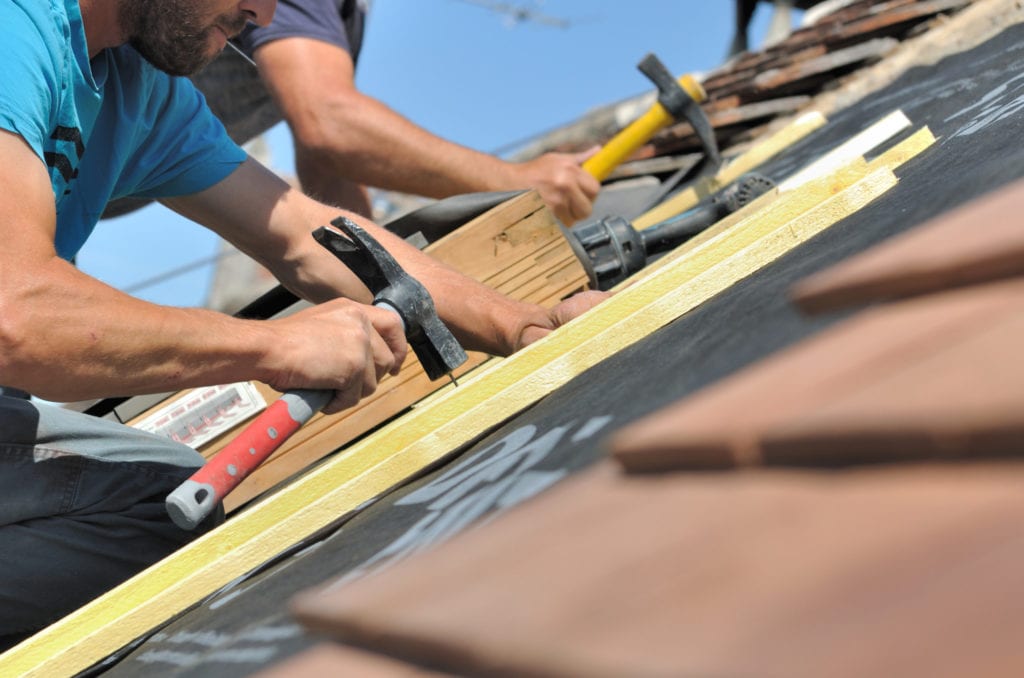
How Much Do Roofers Charge Per Square Foot?
Roofing, being one of the most essential components of any property, needs regular upkeep and eventual replacement. When it comes time to replace or repair your roof, one of the primary concerns is the cost involved. Understanding how roofers charge can help homeowners budget and plan effectively for their roofing needs.
GET ROOFING QUOTES NOWA Deep Dive into Roofing Costs
The cost of roofing can be understood better when broken down into materials, labor, and other miscellaneous expenses.
1. Base Material Costs
The choice of roofing material has the most significant impact on the overall cost. Different materials come with varying price points, lifespans, and aesthetic appeals:
- Asphalt Shingles: These are the most common roofing materials, primarily because they are economical and relatively easy to install. On average, asphalt shingles can cost anywhere from $90 to $100 per square (100 square feet).
- Metal Roofing: A more durable option, metal roofing can range from $300 to $1,200 per square, depending on the type of metal used (like aluminum, steel, copper, or zinc).
- Tile and Slate Roofing: These are high-end materials known for their longevity and premium look. Expect to pay anywhere between $600 and $1,500 per square for these materials.
- Wood Shingles: A more natural look, wood shingles can range between $250 and $600 per square.
2. Labor Costs
Labor costs can vary depending on the region, complexity of the job, and the experience of the roofing company or contractor. Generally, for standard asphalt shingle roofing, labor can range from $50 to $100 per square. However, for more complex materials like slate or tile, labor costs can jump to $300 or more per square because of the expertise required for installation.
GET ROOFING QUOTES NOW3. Additional Expenses
Apart from the primary costs of materials and labor, homeowners should be aware of potential additional expenses:
- Roofing Underlayment: This is a water-resistant or waterproof barrier installed directly onto the roof deck. It can cost between $15 to $60 per square.
- Flashing: These are metal pieces that prevent water seepage at intersections or projections on the roof. Flashing can add $10 to $20 per square.
- Ventilation: Proper ventilation helps regulate attic temperatures and moisture levels. Installing new vents can add a few hundred dollars to the total cost.
- Roof Complexity: A roof with multiple chimneys, skylights, or dormers will have higher installation costs because of the additional work involved around these structures.
- Removal of Old Roof: If a new roof is being installed, the old one must be removed, which can add $100 to $150 per square.

Factors That Influence Pricing
- Geographical Location: Roofing costs vary by region due to differences in labor costs and materials availability.
- Seasonality: Roofers might charge more during their peak season due to high demand.
- Roof Pitch and Slope: Steeper roofs require more materials and are more labor-intensive, increasing the overall cost.
- Warranties: Some contractors offer extended warranties, which might increase the overall price but provide long-term peace of mind.
While the square foot pricing offers a generalized idea, many variables can influence the final cost of a roofing project. It’s essential to get multiple quotes, understand what’s included in the price, and ensure you’re comparing apples to apples when evaluating contractors. Investing time in this initial research can lead to significant savings and a job well done. Below we will take a deeper look into each factor that may affect the cost of hiring a roofer.
GET ROOFING QUOTES NOWThe Role of Geographical Location in Roofing Costs
Geographical location plays a pivotal role in determining the cost of hiring a roofer and the associated expenses for roofing materials and services. Several factors, tied to location, influence these costs, and understanding them can give homeowners a clearer picture of what to expect when budgeting for a roofing project.
1. Regional Labor Rates
Labor rates can fluctuate widely from one region to another. For instance:
- Urban vs. Rural: Typically, urban areas, with their higher living costs, will have higher labor rates compared to rural areas. A roofer in a bustling city like New York or Los Angeles might charge more than one in a less densely populated town in the Midwest.
- State Regulations and Licensing: States with rigorous contractor licensing requirements or higher insurance mandates might see elevated roofing labor costs, as contractors pass these expenses onto the client.
2. Material Availability and Transportation
Certain roofing materials might be more readily available in specific regions:
- Local Resources: Areas with local quarries or manufacturers might have lower costs for specific materials. For instance, slate roofing might be less expensive in regions near slate quarries.
- Transportation Costs: Importing specific materials from distant locations can add to the overall cost. If a particular roofing material isn’t locally produced or readily available, the transportation and import fees can significantly inflate the price.

3. Climate and Weather Patterns
The local climate can dictate the type of roofing material predominantly used in an area:
- Hot and Arid Regions: In places with high temperatures and sun exposure, reflective and UV-resistant roofing materials might be preferred, which could affect the material’s cost and longevity.
- Cold and Snowy Regions: In colder climates, roofing materials that offer better insulation and can withstand the weight of snow might be favored.
- Storm-Prone Areas: Regions that frequently experience hurricanes, tornadoes, or hailstorms might have a preference for more robust and impact-resistant roofing, which can influence both material and installation costs.
4. Competition Among Roofers
The number of roofing contractors in a specific area can impact pricing:
- High Competition: In areas with many roofing contractors, competition can drive prices down as companies vie for business.
- Limited Providers: Conversely, in regions with fewer contractors, homeowners might find less competitive rates.
5. Historical and Building Regulations
In areas with a rich historical heritage or strict building codes, there might be regulations dictating the type of roofing materials that can be used. Adhering to these regulations can sometimes result in higher costs.
6. Economic Factors
Local economic conditions can influence the cost of roofing projects. For instance, areas experiencing economic booms might see inflated labor and material costs due to higher demand, while areas undergoing economic downturns might witness the opposite.
GET ROOFING QUOTES NOWGeographical location weaves a complex web of factors that directly and indirectly influence the cost of hiring a roofer. Before embarking on a roofing project, homeowners should familiarize themselves with local market conditions, consult multiple contractors, and consider region-specific challenges and advantages.


Seasonal Impacts on Roofing Costs
The time of year can play a considerable role in the costs associated with roofing projects. From fluctuating demand to weather conditions, understanding the seasonal dynamics can help homeowners make informed decisions regarding when to initiate their roofing tasks.
1. High Demand Periods
Roofing projects tend to surge during specific times of the year, leading to increased demand for both labor and materials.
- Spring and Early Summer: After the cold winter months, many homeowners start their home improvement projects, including roofing, during the spring. This uptick continues into the early summer months when weather conditions are optimal, leading to increased demand for roofers and materials. During these times, homeowners might find contractors are booked well in advance, and prices might be slightly elevated due to the high demand.
- After Major Weather Events: Following significant weather disturbances, such as hurricanes, tornadoes, or hailstorms, there is often a spike in roofing projects due to damage repair and roof replacement needs. During these times, local contractors might be overwhelmed with jobs, leading to longer wait times and potentially higher prices.
2. Off-Peak Seasons
There are periods during the year when the demand for roofing projects tends to dip.
- Late Fall and Winter: These colder months typically see a decline in roofing projects, primarily due to less predictable weather conditions and the challenges of roofing in colder temperatures. However, for homeowners who are willing to brave potential weather-related rescheduling, this period might offer some cost savings as roofers may reduce their rates to secure jobs during the leaner months.
3. Material Costs
Roofing material prices can fluctuate seasonally. For example, during high-demand periods, certain materials might be in shorter supply, leading to increased prices. On the other hand, during off-peak times, suppliers might offer discounts or promotions to move stock.
4. Weather Considerations
Weather plays a crucial role in roofing. Wet or icy conditions can be hazardous for roofers and can compromise the quality of the roofing installation.
- Rainy Season: Roofing during wet conditions can lead to delays, potentially driving up labor costs. Moisture can also impact the integrity of certain roofing materials.
- Cold Weather: Some materials, especially asphalt shingles, can become brittle and more challenging to install during colder temperatures. Additionally, adhesives used in roofing might not set correctly if it’s too cold.
5. Future Planning
Given the seasonal fluctuations in demand and costs, homeowners who are considering roofing projects but are not in a hurry can benefit from planning. By scheduling their projects during off-peak times or booking contractors well in advance for peak periods, homeowners can potentially achieve some savings and ensure the availability of their preferred contractors.


While immediate needs might not offer the luxury of choosing the timing for a roofing project, understanding the seasonal impacts on costs can offer significant advantages in terms of budgeting and planning for those with flexibility.
GET ROOFING QUOTES NOWThe Influence of Pitch and Slope on Roofing Costs
The pitch and slope of a roof are integral factors in determining not just the look and design of your home but also the cost when it comes to hiring a roofer for replacements or repairs. Here’s a closer look at how these two elements influence the price.
Understanding Pitch and Slope
Before diving into the cost implications, it’s essential to understand what pitch and slope mean in roofing terms.
- Pitch: This refers to the vertical rise of a roof relative to its horizontal span. It’s often expressed as a ratio, indicating the rise for every foot of horizontal run. For instance, a “4 in 12” pitch means that the roof rises 4 inches for every 12 inches of run.
- Slope: While often used interchangeably with pitch, slope is typically understood as the angle a roof surface makes with the horizontal plane. It’s an expression of incline, and a steeper slope means a steeper roof.
Cost Implications of Pitch and Slope
- Material Requirements: A steeper roof will have a larger surface area than a flatter one covering the same footprint of a house. More material will be required to cover a steep roof, which can increase costs.
- Labor Intensity: Steep roofs are more challenging and can be dangerous for workers. Roofing on steeper surfaces often requires additional safety measures, specialized equipment, and sometimes even more laborers to ensure the job is done safely and correctly.
- Type of Materials: Some roofing materials are better suited for steep roofs, while others are ideal for flatter surfaces. The pitch and slope can limit your material choices, and some materials might be more expensive than others. For example, slate and tile roofs are heavy but can be ideal for steeper pitches, whereas rubber membranes are often used for low-sloped roofs.
- Water Drainage and Lifespan: Steeper roofs tend to have better water drainage, which can prolong the life of the roof. While this might save money in the long run due to reduced maintenance and repair costs, the initial installation might be pricier.
- Inspections and Maintenance: Roofs with a steeper pitch can be more challenging to inspect and maintain. Simple tasks like cleaning gutters, removing debris, or even just getting a visual check can become more labor-intensive and, thus, more costly.
- Specialized Skills: Not every roofing contractor has experience or is comfortable working on very steep roofs. Those who specialize in such roofs might charge a premium for their unique skills and expertise.
When considering the overall costs associated with roofing, the pitch and slope play pivotal roles. Homeowners should be aware of these factors and discuss them with potential contractors to get accurate estimates. Additionally, while steeper roofs might incur higher initial costs, the potential benefits in terms of aesthetics, longevity, and drainage should also be considered in the overall investment decision.


Roof Warranties: What’s Covered and What’s Not?
Roof warranties are a crucial aspect of any roofing project, providing homeowners with peace of mind and assurance that their significant investment is protected. However, understanding what’s covered under a warranty, its duration, and potential exclusions is essential for avoiding unpleasant surprises down the road. Let’s delve into the intricacies of roof warranties and distinguish between the inclusions and exclusions.
Types of Roof Warranties
- Manufacturer’s Warranty: This is provided by the company that produced the roofing materials. It typically covers defects in the manufacturing process and ensures that the products will last as long as the manufacturer claims when properly installed.
- Workmanship Warranty: Offered by the roofing contractor, this warranty covers errors in installation. If the roof fails or leaks due to improper installation, the contractor is liable to make repairs at no additional cost.
What’s Generally Covered
- Material Defects: Most manufacturer warranties will cover any defects in the roofing materials. If the shingles or tiles start to degrade prematurely or have inherent flaws, the manufacturer will provide replacements.
- Labor Costs: Some comprehensive warranties will also cover the labor costs associated with replacing defective materials, especially if the issue is identified within a specific timeframe after installation.
- Transferability: Some warranties can be transferred to a new homeowner if the property is sold. This can be a selling point as the new owner will benefit from the remaining warranty period.



What’s Often Excluded
- Improper Installation: If a manufacturer determines that their materials failed due to improper installation, they might not honor the warranty. This is where the workmanship warranty from the contractor becomes crucial.
- Normal Wear and Tear: Roofs naturally degrade over time due to exposure to elements. Warranties do not typically cover regular aging or wear and tear.
- Act of God and Severe Weather Events: Natural disasters such as hurricanes, tornadoes, hailstorms, or any unpredictable and uncontrollable events are often not covered under standard warranties.
- Poor Maintenance: If a homeowner neglects regular roof maintenance and this neglect leads to issues, those problems might not be covered.
- Structural Changes: Any modifications or renovations made to the roof or home that affect the roof’s performance can void the warranty.
- Ventilation Issues: Roofs require proper ventilation. If damage occurs due to improper ventilation, this may not be covered.
Understanding Duration and Proration
Roof warranties also come with specific durations, ranging from 10 years to “lifetime.” It’s essential to understand whether a warranty is prorated or non-prorated. A prorated warranty means that as the roof ages, the compensation you receive for defects decreases. In contrast, non-prorated warranties will cover 100% of the costs for the entire duration of the warranty.
A roof warranty is a valuable part of your roofing investment. However, homeowners should take the time to thoroughly understand its terms. It’s advisable to keep a copy of your warranty documents and maintain your roof properly. By doing so, should an issue arise, the process of making a claim becomes smoother, ensuring that your roof remains in optimal condition for years to come.
GET ROOFING QUOTES NOW
Leave a Reply